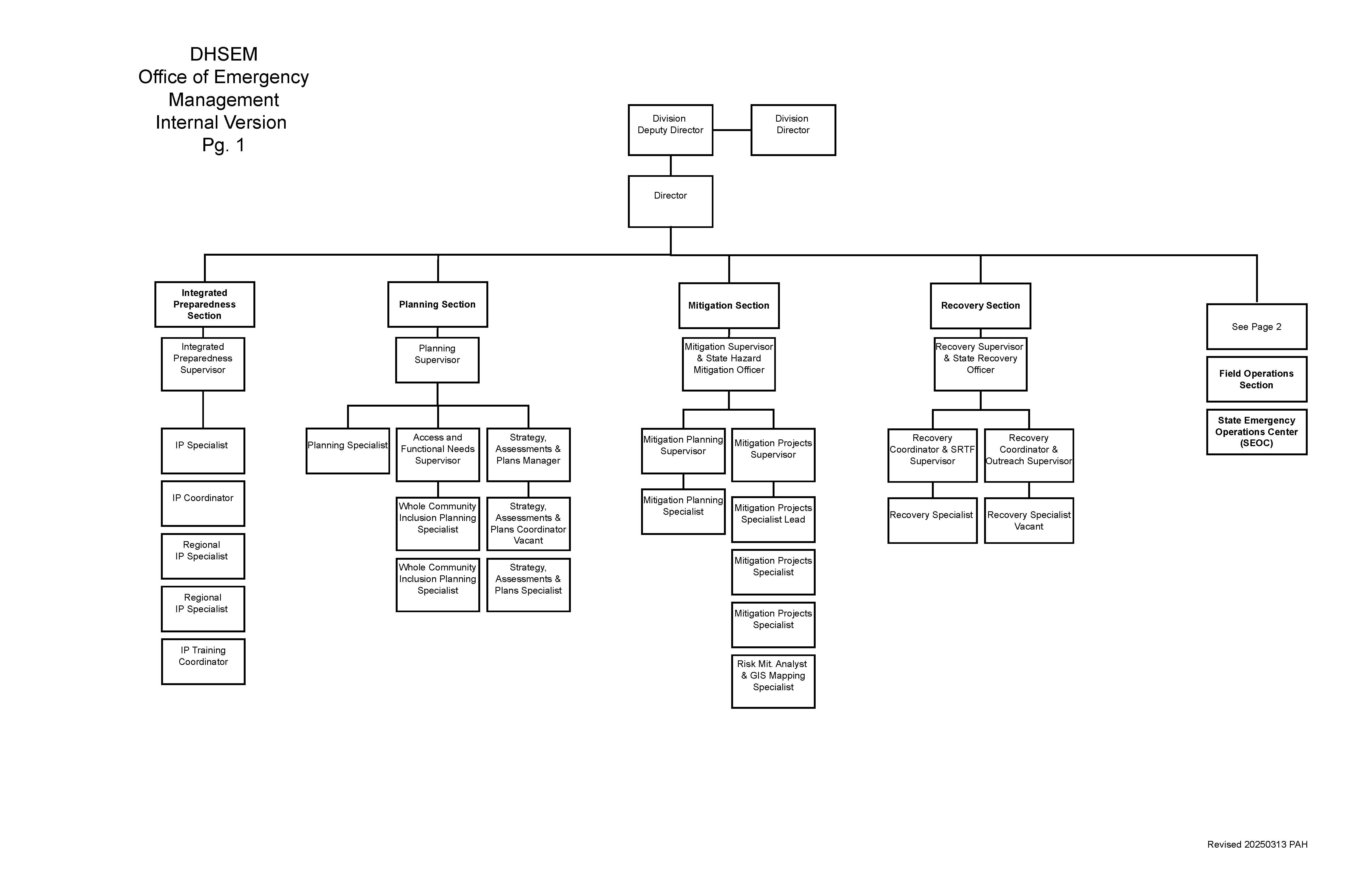Emergency Management Office Organization Chart
The Office of Emergency Management conducts four phases of emergency management (preparedness, response, mitigation and recovery) in coordination with other state agencies and in support of local jurisdictions. It integrates emergency management efforts across all levels of government, including state, local, tribal and federal.
Planning Section
The section conducts the division’s integrated planning efforts and is split into two units: Operational Planning and Access and Functional Needs Unit. Both units provide planning support to the division, state agencies and stakeholders and local emergency managers as required. This includes, but is not limited to:
- Operational Planning Unit
- State Emergency Operations Plan and Annexes
- Resource Mobilization Plans
- Colorado Emergency Preparedness Assessment (CEPA)/ Threat Hazard Identification and Risk Assessment / Hazard Identification and Risk Assessment/ State Preparedness Report
- Debris Management Planning
- Access and Functional Needs Unit
- Access and Functional Needs Integration
Integrated Preparedness Section
This section conducts training and exercises for state and local jurisdictions. It develops and maintains a statewide inter-departmental exercise calendar and provides training and exercise support to stakeholders. This includes, but is not limited to:
- State and Local Training and Exercise:
- Academies Planning and Execution (Wildland Fire Academy, Emergency Management Academy)
- Co-Train and Local Training Assistance
- Local Exercise Development and Support
- Develop and Maintain an Exercise Library
- Inter-departmental Exercise Integration and Synchronization
- State Training and Exercise Planning Workshop
State Emergency Operations Center Section
This section operates the State Emergency Operations Center (SEOC) at the approved level and maintains situational awareness throughout the state. It conducts internal training, including training with emergency support functions (ESFs)/ emergency response coordinators (ERCs) and participates in the statewide integrated preparedness program. It develops and maintains internal and external standard operating procedures. It maintains visibility of resources and, as required, coordinates and provides resources Governor Executive Orders and/or State Statue. This includes, but is not limited to:
- SEOC Operations
- Statewide Situational Awareness in Coordination with Field Operations and Other State Agencies
- Maintenance of OEM Operational Rhythm
- State Emergency Operations Center Operations in Accordance with Approved Level
- Internal Communications Operations Including WebEOC
- Inter-departmental Training and Coordination with Emergency Support Functions/Emergency Response Coordinators
- Emergency Management Assistance Compact planning and coordination
- Continuity of Operations Planning (COOP)
- Private Sector Liaison
- Voluntary Agency Liaison
- Logistics Operations
- Resource Visibility and Status
- Resource Mobilization/Demobilization
- EMAC Execution
- Maintenance and Delivery of Communications Equipment
- Logistics Planning Support and Expertise
State Mitigation Section
This section provides mitigation planning assistance and project management in coordination with local jurisdictions. It conducts mitigation training and education for local jurisdictions. It coordinates with the preparedness section to integrate mitigation into state emergency management plans. Additionally, the section lead serves as the State Mitigation Officer. This section has two units whose responsibilities include, but are not limited to:
- Mitigations Plans Unit
- Develop the State Hazards Mitigation Plan
- Coordinate with and Advise Local Jurisdictions Regarding Mitigation Planning
- Conduct Mitigation Training for Local Jurisdictions
- Mitigation Project Unit
- Provide Technical Oversight and Project Management for Local Mitigation Projects
- Coordinate with the Office of Grants Management for Grant Administration
State Recovery Section
This section trains, prepares and, as required, activates the State Recovery Task Force ( SRTF). Pre-disaster, the section assists both the plans and the integrated preparedness sections with recovery training and planning for local jurisdictions. This officer coordinates and integrates DHSEM recovery planning with other state agencies to ensure seamless recovery efforts across state government. Upon direction from the DHSEM Director, this officer activates and leads the SRTF and, if required, integrates the SRTF into a Joint Recovery Task Force (JRTF) in coordination with FEMA. This officer’s responsibilities include, but are not limited to:
- When Directed: Stand Up and Lead the State Recovery Task Force
- When Directed: Integrate the State Recovery Task Force into a Joint Recovery Task Force
- Train the State Recovery Task Force
- In Coordination with the Planning and Training and Exercise Sections, Integrate Recovery into Plans and Training Programs
- Coordinate with the Department of Local Affairs and other State Agency Recovery Offices to Integrate Plans and Efforts
Field Operations Section
This section provides technical assistance and operational support to local emergency managers, homeland security coordinators and their respective staffs. This includes, but is not limited to:
- Field Services Managers
- Technical Assistance to State and Local Programs
- Communication and Coordination between DHSEM and Locals
- Inter-departmental Communication and Coordination with other State Agencies and Local Representatives (Fire Management Officers, Department of Local Affairs Field Reps, Colorado Department of Transportation, Colorado Department of Public Health and Environment, Department of Natural Resources, etc)
- Regional Situational Awareness and Reporting
- Integration of Regional Operating Picture into State Emergency Operations Center Statewide Operating Picture
- EMPG Planning and Operational Oversight
- IMT and AuxComm Coordinator
- Training and Qualifications Management of State All-Hazards Incident Management Team System
- Status Reporting of All-Hazards Incident Management Team Individuals and Teams
- Employment/Deployment Recommendations
- Program Management of State Funds for All-Hazards Incident Management Teams
- Oversight of AuxComm Program
Organizational Chart
View or download the Office of Emergency Management Organizational Chart.

